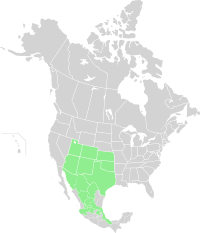Senecio flaccidus
| Threadleaf ragwort | |
|---|---|

| |
| Threadleaf ragwort | |
| Scientific classification | |
| Kingdom: | Plantae |
| Clade: | Tracheophytes |
| Clade: | Angiosperms |
| Clade: | Eudicots |
| Clade: | Asterids |
| Order: | Asterales |
| Family: | Asteraceae |
| Genus: | Senecio |
| Species: | S. flaccidus
|
| Binomial name | |
| Senecio flaccidus | |

| |
| Range of S. flaccidus | |
| Synonyms | |
|
Senecio longilobus Benth | |
Senecio flaccidus, formerly recorded as Senecio douglasii (in honor of the botanist David Douglas), member of the daisy family and genus Senecio also known as threadleaf ragwort[3] (and threadleaf groundsel, bush senecio, creek senecio, shrubby butterweed, comb butterweed, smooth threadleaf ragwort, Mono ragwort, Douglas ragwort, Douglas groundsel, sand wash groundsel, felty groundsel, old man, yerba cana, squawweed or cenicillo), is a native of the southwestern Great Plains of North America.[4][5][6][7]
Description
[edit]Threadleaf ragwort is a fast-growing, short-lived (3 to 6 years) bushy perennial shrub growing to 4 feet 6 inches (1.37 m); common in gravelly washes, dry creek beds, along roads and trails and mostly away from the coast.[5]
- Leaves and Stems
- Branched and bushy, Senecio flaccidus gets its common name from its white, threadlike, bent and matted, tomentose leaves; alternate and deeply pinnate, divided into five to nine narrow linear segments, glabrous, having no hairs or projections, gray-green above, 1 to 4 inches (2.5 to 10.2 cm) long. The principal leaves often have auxiliary clusters of smaller leaves.[5] The stems are grooved and the branches are thin, herbaceous above and woody near the base.[4][5]
- Flowers
- Showy flowering heads of yellow ray flowers, 3–4 inches (7.6–10.2 cm) across; eight to thirteen sterile rays, purplish brown disk florets that produce the seeds.[5][6]
- Seeds
- Dicotyledon fruits; each a 1⁄8 inch (3.2 mm) long achene ribbed and hoary, covered with short white hairs.[4][5][6]
Toxicity
[edit]Colonizing disturbed areas including over-grazed lands, Senecio flaccidus helps to achieve a quick ground cover and helps to stabilize the soil for longer-lived perennials but in this situation makes poor foraging for cattle and horses due to the alkaloids contained in the plant which cause liver disease when consumed in large quantities.[7]
Also known as Senecio longilobus, one of the alkaloids found in this species is longilobine,[8] as well as senecionine, seneciphylline, florosenine, otonecine-based florosenine, and retrorsine.[7]
Distribution
[edit]Like many Senecio Senecio flaccidus likes disturbed habitats, this one preferring overgrazed rangelands, dried up stream beds and desert grasslands;[7] at altitudes above 1,800 feet (550 m) and below 6,500 feet (2,000 m).[6]

- America
- North-Central: Kansas, Oklahoma
- Northwestern: Colorado
- South-Central: New Mexico, Texas
- Southwestern: Arizona, Utah
- Northern Mexico: Chihuahua, Coahuila, Durango, San Luis Potosí, Sonora, Zacatecas
- Central Mexico: Aguascalientes, Guanajuato, Hidalgo, Jalisco (n.e.), Veracruz
- America
- North-Central: Kansas, Oklahoma, Wyoming
- Northwestern: Colorado
- South-Central: New Mexico, Texas
- Southwestern: Arizona, California, Nevada, Utah
- Northern Mexico: Chihuahua, Coahuila, Durango, San Luis Potosí, Sonora, Zacatecas, Baja California
- Central Mexico: Aguascalientes, Baja Norte, Guanajuato, Hidalgo, Jalisco (n.e.), Veracruz
Subspecies which are synonyms
[edit]- Senecio flaccidus Less. var. flaccidus
- Senecio douglasii DC. var. longilobus (Benth.) L.D. Benson
- Senecio douglasii DC. var. jamesii (Torr. & A. Gray) Ediger ex Correll & M.C. Johnst.
- Senecio douglasii DC. ssp. longilobus (Benth.) W.A. Weber[1]
- Senecio flaccidus Less. var. monoensis (Greene) B. L. Turner & T. M. Barkley
- Senecio flaccidus Less. var. douglasii (DC.) B. L. Turner & T. M. Barkley
- Senecio flaccidus var. flaccidus[2]
See also
[edit]References
[edit]- ^ a b c d e Natural Resources Conservation Service (NRCS). "PLANTS Profile, Senecio flaccidus Less. var. flaccidus". The PLANTS Database. United States Department of Agriculture. Retrieved 20 February 2008.
- ^ a b c d "Senecio flaccidus". Germplasm Resources Information Network. Agricultural Research Service, United States Department of Agriculture. Retrieved 20 February 2008.
- ^ NRCS. "Senecio flaccidus". PLANTS Database. United States Department of Agriculture (USDA). Retrieved 9 November 2015.
- ^ a b c Oklahoma Biological Survey (20 September 1999). "Senecio flaccidus Less. var. flaccidus". Scientific Name Index. University of Oklahoma. Retrieved 20 February 2008.
- ^ a b c d e f Michael L. Charters. "Senecio flaccidus Less. var. douglasii (DC) B. Turner & T. Barkley". Wildflowers and Other Plants of Southern California. Retrieved 20 February 2008.
- ^ a b c d George DeLange; Audrey DeLange. "Sand Wash Groundsel". Arizona Wild Flowers Wildflower Pictures And Photos. Retrieved 20 February 2008.
- ^ a b c d e James E. Nellessen. "Senecio flaccidus Less" (PDF). United States Fish and Wildlife Service. Retrieved 20 February 2008.
- ^ Henderson FG, Harris PN, Chen KK (March 1951). "Liver injury following administration of alpha- and beta- longilobine". Proceedings of the Society for Experimental Biology and Medicine. 76 (3): 530–532. doi:10.3181/00379727-76-18545. PMID 14844262. S2CID 75269601. 14844262.
External links
[edit]![]() Data related to Senecio flaccidus at Wikispecies
Data related to Senecio flaccidus at Wikispecies
![]() Media related to Senecio flaccidus at Wikimedia Commons
Media related to Senecio flaccidus at Wikimedia Commons
- Integrated Taxonomic Information System Organization (ITIS) (20 December 2007). "Senecio flaccidus". Integrated Taxonomic Information System on-line database. Retrieved 20 February 2008.
- Arizona Vascular Plant Herbarium. "Senecio flaccidus". Southwest Environmental Information Network. Retrieved 20 February 2008.
- Calflora. "Taxon Report – 7491". Information on California plants for education, research and conservation. The Calflora Database. Retrieved 20 February 2008.
{{cite web}}: External link in|publisher=

